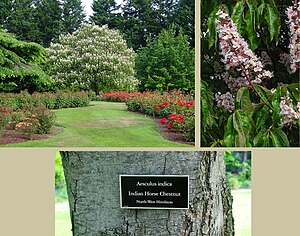Indian horse chestnut
| Indian horse chestnut | ||||||||||||
|---|---|---|---|---|---|---|---|---|---|---|---|---|

Indian horse chestnut ( Aesculus indica ) |
||||||||||||
| Systematics | ||||||||||||
|
||||||||||||
| Scientific name | ||||||||||||
| Aesculus indica | ||||||||||||
| ( Wall. Ex Camb. ) Hook. |
The Indian horse chestnut ( Aesculus indica ) is a species of horse chestnut ( Aesculus ) in the soap tree family (Sapindaceae).
description
Vegetative characteristics
The Indian horse chestnut is a deciduous tree that can reach heights of up to 30 meters; outside of its natural range, it remains significantly smaller and barely reaches 20 meters in height. The gray bark of the trunk comes off in long strips.
The constantly against arranged on the branches leaves are divided into petiole and leaf blade. The petiole is 10 to 15 inches long. The fingered leaf blade consists of seven parts (sometimes five or nine parts). The approximately 1 centimeter long, stalked, almost sessile leaflets are up to 20 centimeters long and narrow , obovate to lanceolate, and glabrous on both sides and finely serrated on the edge. The fresh shoot is usually colored red for some time.
Generative characteristics
The flowering period extends from June to July. The paniculate inflorescence is 20 to 30 centimeters long.
The hermaphrodite flowers are four to five-fold. The five sepals are fused into a tube about 5 mm long. The four white to pink, sometimes yellowish, petals are unevenly shaped. There are seven free stamens 2 to 2.5 mm long . Three carpels have become an ovary grown.
The round, three-lobed, 4 to 6 centimeter long capsule fruits , slightly drop-shaped towards the base of the stem, are rough, but not prickly. The medium-sized brown, shiny seeds contained therein ripen from the beginning of October.
Occurrence
The Indian horse chestnut comes from Asia , where it occurs naturally in the north-western Himalayas at higher altitudes of around 1500 to 3000 meters. Its distribution area extends over eastern Afghanistan , northern India , Nepal and northern Pakistan .
use
Outside of its natural range, it is occasionally planted as an ornamental tree in botanical gardens, parks and gardens . In Central Europe it is only sufficiently hardy in winter-mild areas or in sheltered places; however, it thrives outdoors in the British Isles and southern Europe.
variety
From the Indian horse chestnut there is the variety Aesculus indica 'Sydney Pearce', which remains smaller and whose flowers are more whitish-yellow and less pink than the species.
Taxonomy
The first description was under the name ( Basionym ) Pavia indica Wall. ex Cambess. in Venceslas Victor Jacquemont: Voyage dans l'Inde 4 (Bot.) , Volume 31, Plate 35. The new combination to Aesculus indica was published in 1859 by the British botanist William Jackson Hooker in Botanical Magazine , Volume 85, Plate 5117.
literature
- Alan Mitchell, translated and edited by Gerd Krüssmann: The forest and park trees of Europe: An identification book for dendrologists and nature lovers . Paul Parey, Hamburg and Berlin 1975, ISBN 3-490-05918-2 .
Web links
- Aesculus indica in the Flora of Pakistan . (engl.)
- Characteristics.
- Aesculus indica at Plants For A Future

